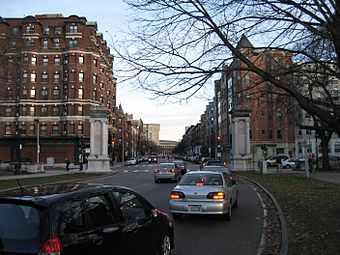Fenway-Boylston Street District facts for kids
Quick facts for kids |
|
|
Fenway-Boylston Street District
|
|

Beginning of Westland Avenue at the intersection of Hemenway Street and Fenway.
|
|
| Location | Boston, Massachusetts |
|---|---|
| Area | 3.25 acres (1.32 ha) |
| Built | 1891 |
| Architect | Multiple |
| Architectural style | Colonial Revival, Classical Revival, Queen Anne |
| NRHP reference No. | 84002875 |
| Added to NRHP | September 4, 1984 |
The Fenway-Boylston Street District is a special area in Boston, Massachusetts, filled with old and beautiful homes. It's called a historic district because these buildings show how people lived and built things a long time ago. Most of these homes were built starting in the 1890s. They were designed by famous architects for some of Boston's most important families. This district was officially recognized as a historic place in 1984.
Contents
Exploring the Fenway-Boylston District
This historic district is found on the east side of Boston's Back Bay Fens. This is a large public park designed by Frederick Law Olmsted. He was a very famous landscape architect. The parkway, called The Fenway, was built in the 1880s when the park was created.
Homes and Buildings from the Past
The buildings along The Fenway were originally built as homes. They stand between the parkway and Hemenway Street. These houses were built between 1890 and about 1910. They are made of strong brick and stone. You can see different styles of architecture here. Some are fancy Queen Anne or Beaux Arts styles. Others are more simple Classical Revival.
Even though the area was planned for homes, some important organizations also built there. Today, many buildings are used by students from nearby schools. At the southern end of the district, you'll find the Massachusetts Historical Society. This building is a National Historic Landmark. It sits where The Fenway meets Boylston Street.
Famous Architects and Their Designs
Just east of the Massachusetts Historical Society is the old Chambers Hotel. This Beaux Arts building was designed by Arthur H. Bowditch. It was finished in 1901. Another important building is the one built for the Boston Medical Library. It's located at 18 The Fenway.
Next door to the library is the townhouse of Robert Swain Peabody. He was a main partner in a very important architectural firm called Peabody and Stearns. He designed his own home and two houses next to it. Other famous Boston architects, like Alexander Wadsworth Longfellow Jr., also designed buildings on this block.
The Johnson Memorial Gate
The historic district also includes the Johnson Memorial Gate. This gate is where Westland Avenue enters the park. It was designed by Guy Lowell. He also designed the Boston Museum of Fine Arts, which is nearby but outside this district.



